ignition Hyundai Creta 2019 Owner's Manual
[x] Cancel search | Manufacturer: HYUNDAI, Model Year: 2019, Model line: Creta, Model: Hyundai Creta 2019Pages: 472, PDF Size: 13.39 MB
Page 17 of 472
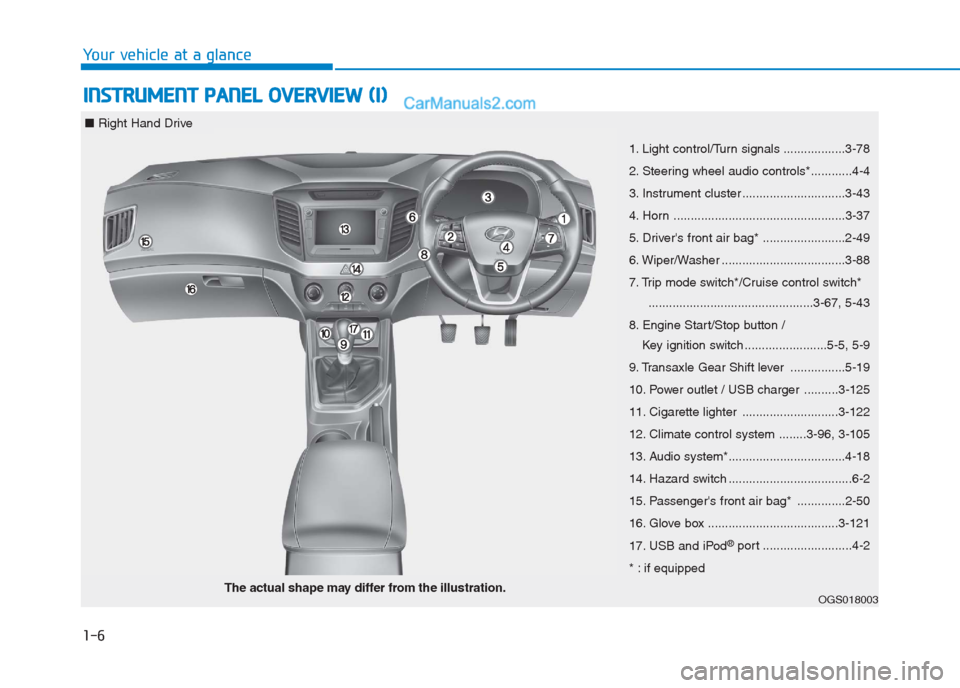
1-6
Your vehicle at a glance
I IN
NS
ST
TR
RU
UM
ME
EN
NT
T
P
PA
AN
NE
EL
L
O
OV
VE
ER
RV
VI
IE
EW
W
(
(I
I)
)
1. Light control/Turn signals ..................3-78
2. Steering wheel audio controls*............4-4
3. Instrument cluster ..............................3-43
4. Horn ..................................................3-37
5. Driver's front air bag* ........................2-49
6. Wiper/Washer ....................................3-88
7. Trip mode switch*/Cruise control switch*
................................................3-67, 5-43
8. Engine Start/Stop button /
Key ignition switch ........................5-5, 5-9
9. Transaxle Gear Shift lever ................5-19
10. Power outlet / USB charger ..........3-125
11. Cigarette lighter ............................3-122
12. Climate control system ........3-96, 3-105
13. Audio system*..................................4-18
14. Hazard switch ....................................6-2
15. Passenger's front air bag* ..............2-50
16. Glove box ......................................3-121
17. USB and iPod
®port ..........................4-2
* : if equipped
OGS018003The actual shape may differ from the illustration.
■Right Hand Drive
Page 18 of 472
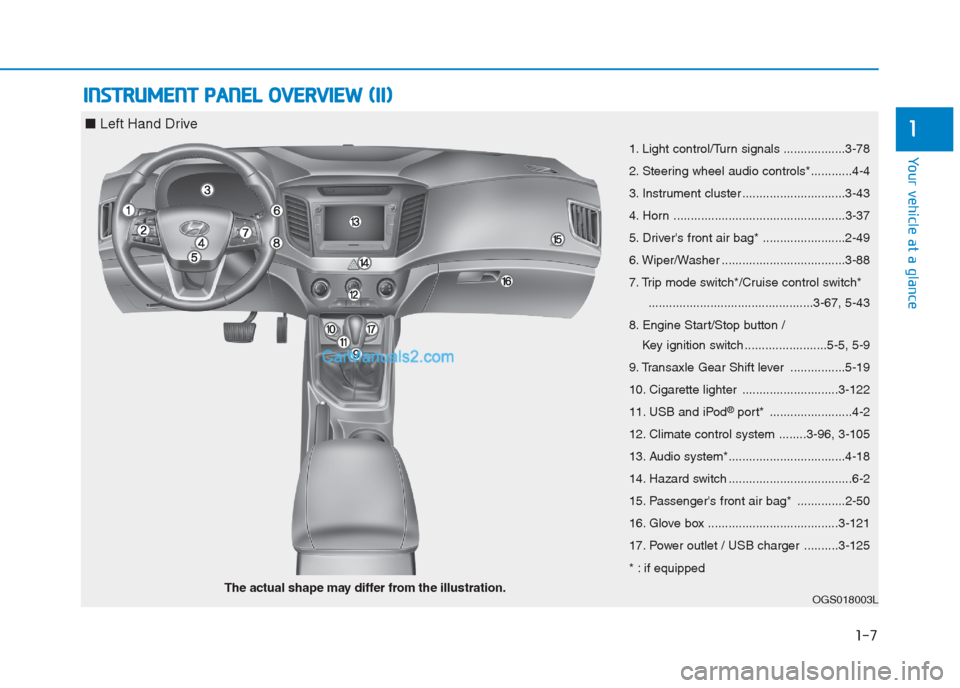
1-7
Your vehicle at a glance
I IN
NS
ST
TR
RU
UM
ME
EN
NT
T
P
PA
AN
NE
EL
L
O
OV
VE
ER
RV
VI
IE
EW
W
(
(I
II
I)
)
1
1. Light control/Turn signals ..................3-78
2. Steering wheel audio controls*............4-4
3. Instrument cluster ..............................3-43
4. Horn ..................................................3-37
5. Driver's front air bag* ........................2-49
6. Wiper/Washer ....................................3-88
7. Trip mode switch*/Cruise control switch*
................................................3-67, 5-43
8. Engine Start/Stop button /
Key ignition switch ........................5-5, 5-9
9. Transaxle Gear Shift lever ................5-19
10. Cigarette lighter ............................3-122
11. USB and iPod
®port* ........................4-2
12. Climate control system ........3-96, 3-105
13. Audio system*..................................4-18
14. Hazard switch ....................................6-2
15. Passenger's front air bag* ..............2-50
16. Glove box ......................................3-121
17. Power outlet / USB charger ..........3-125
* : if equipped
OGS018003LThe actual shape may differ from the illustration.
■Left Hand Drive
Page 41 of 472
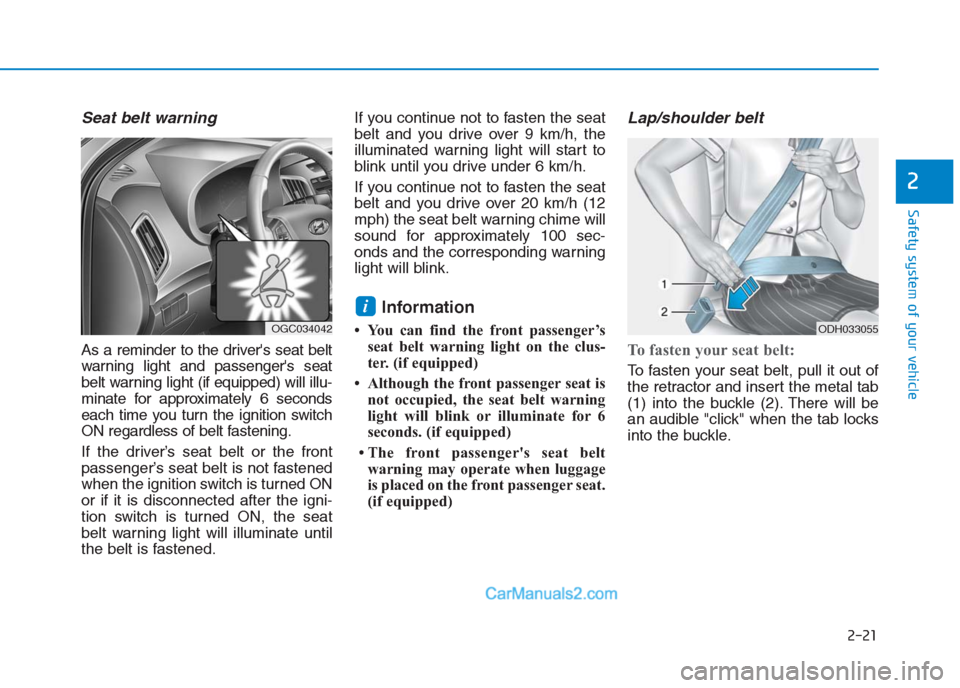
2-21
Safety system of your vehicle
2
Seat belt warning
As a reminder to the driver's seat belt
warning light and passenger's seat
belt warning light (if equipped) will illu-
minate for approximately 6 seconds
each time you turn the ignition switch
ON regardless of belt fastening.
If the driver’s seat belt or the front
passenger’s seat belt is not fastened
when the ignition switch is turned ON
or if it is disconnected after the igni-
tion switch is turned ON, the seat
belt warning light will illuminate until
the belt is fastened.If you continue not to fasten the seat
belt and you drive over 9 km/h, the
illuminated warning light will start to
blink until you drive under 6 km/h.
If you continue not to fasten the seat
belt and you drive over 20 km/h (12
mph) the seat belt warning chime will
sound for approximately 100 sec-
onds and the corresponding warning
light will blink.
Information
• You can find the front passenger’s
seat belt warning light on the clus-
ter. (if equipped)
• Although the front passenger seat is
not occupied, the seat belt warning
light will blink or illuminate for 6
seconds. (if equipped)
• The front passenger's seat belt
warning may operate when luggage
is placed on the front passenger seat.
(if equipped)
Lap/shoulder belt
To fasten your seat belt:
To fasten your seat belt, pull it out of
the retractor and insert the metal tab
(1) into the buckle (2). There will be
an audible "click" when the tab locks
into the buckle.
i
OGC034042ODH033055
Page 47 of 472
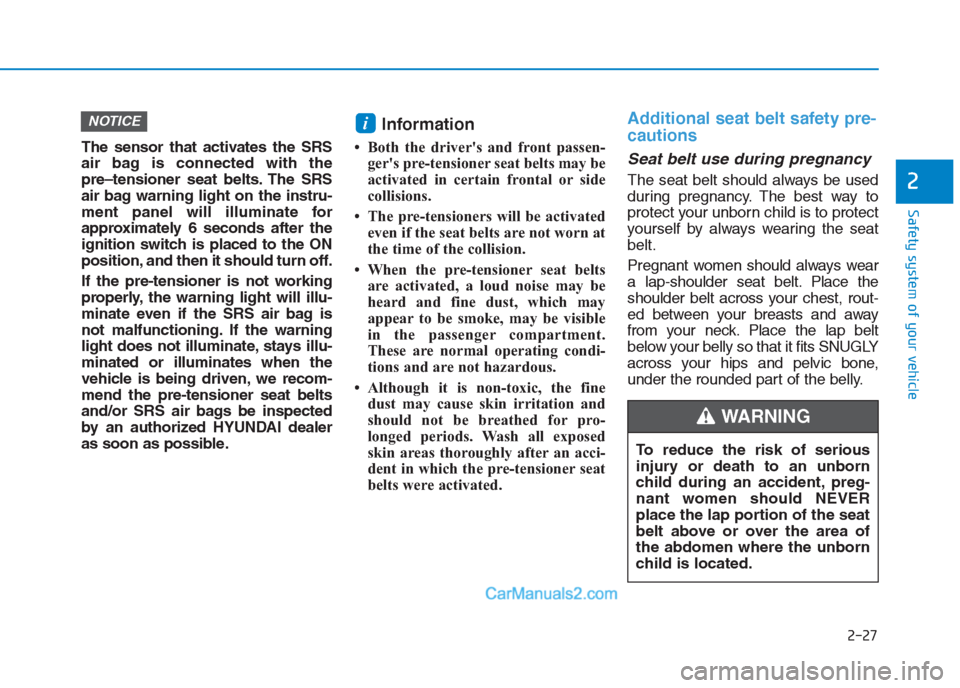
2-27
Safety system of your vehicle
2
The sensor that activates the SRS
air bag is connected with the
pre–tensioner seat belts. The SRS
air bag warning light on the instru-
ment panel will illuminate for
approximately 6 seconds after the
ignition switch is placed to the ON
position, and then it should turn off.
If the pre-tensioner is not working
properly, the warning light will illu-
minate even if the SRS air bag is
not malfunctioning. If the warning
light does not illuminate, stays illu-
minated or illuminates when the
vehicle is being driven, we recom-
mend the pre-tensioner seat belts
and/or SRS air bags be inspected
by an authorized HYUNDAI dealer
as soon as possible.
Information
• Both the driver's and front passen-
ger's pre-tensioner seat belts may be
activated in certain frontal or side
collisions.
• The pre-tensioners will be activated
even if the seat belts are not worn at
the time of the collision.
• When the pre-tensioner seat belts
are activated, a loud noise may be
heard and fine dust, which may
appear to be smoke, may be visible
in the passenger compartment.
These are normal operating condi-
tions and are not hazardous.
• Although it is non-toxic, the fine
dust may cause skin irritation and
should not be breathed for pro-
longed periods. Wash all exposed
skin areas thoroughly after an acci-
dent in which the pre-tensioner seat
belts were activated.
Additional seat belt safety pre-
cautions
Seat belt use during pregnancy
The seat belt should always be used
during pregnancy. The best way to
protect your unborn child is to protect
yourself by always wearing the seat
belt.
Pregnant women should always wear
a lap-shoulder seat belt. Place the
shoulder belt across your chest, rout-
ed between your breasts and away
from your neck. Place the lap belt
below your belly so that it fits SNUGLY
across your hips and pelvic bone,
under the rounded part of the belly.
iNOTICE
To reduce the risk of serious
injury or death to an unborn
child during an accident, preg-
nant women should NEVER
place the lap portion of the seat
belt above or over the area of
the abdomen where the unborn
child is located.
WARNING
Page 65 of 472
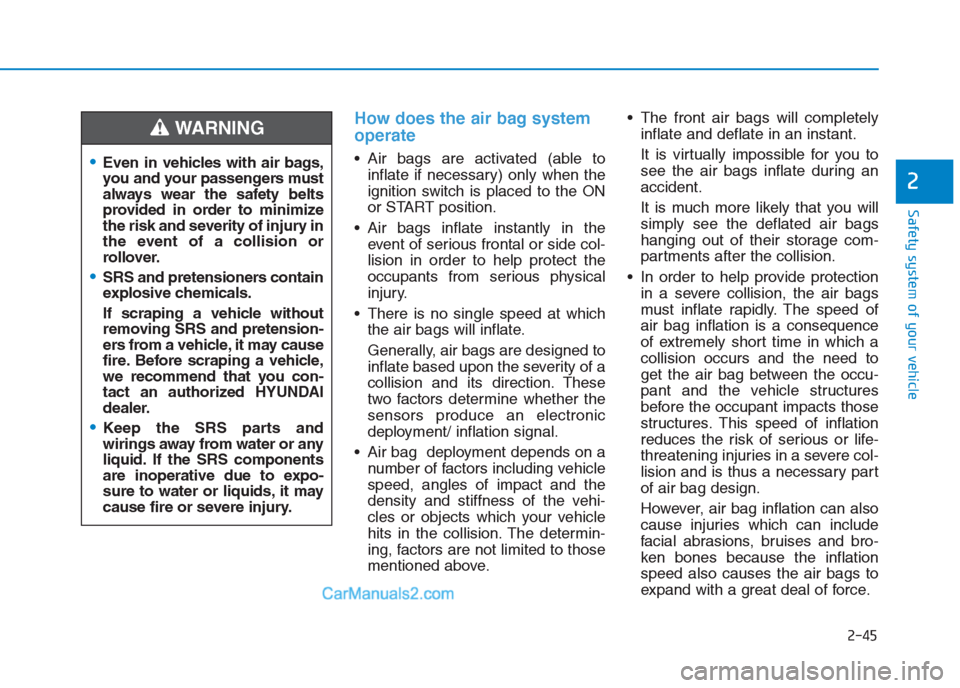
2-45
Safety system of your vehicle
2
How does the air bag system
operate
Air bags are activated (able to
inflate if necessary) only when the
ignition switch is placed to the ON
or START position.
Air bags inflate instantly in the
event of serious frontal or side col-
lision in order to help protect the
occupants from serious physical
injury.
There is no single speed at which
the air bags will inflate.
Generally, air bags are designed to
inflate based upon the severity of a
collision and its direction. These
two factors determine whether the
sensors produce an electronic
deployment/ inflation signal.
Air bag deployment depends on a
number of factors including vehicle
speed, angles of impact and the
density and stiffness of the vehi-
cles or objects which your vehicle
hits in the collision. The determin-
ing, factors are not limited to those
mentioned above. The front air bags will completely
inflate and deflate in an instant.
It is virtually impossible for you to
see the air bags inflate during an
accident.
It is much more likely that you will
simply see the deflated air bags
hanging out of their storage com-
partments after the collision.
In order to help provide protection
in a severe collision, the air bags
must inflate rapidly. The speed of
air bag inflation is a consequence
of extremely short time in which a
collision occurs and the need to
get the air bag between the occu-
pant and the vehicle structures
before the occupant impacts those
structures. This speed of inflation
reduces the risk of serious or life-
threatening injuries in a severe col-
lision and is thus a necessary part
of air bag design.
However, air bag inflation can also
cause injuries which can include
facial abrasions, bruises and bro-
ken bones because the inflation
speed also causes the air bags to
expand with a great deal of force.Even in vehicles with air bags,
you and your passengers must
always wear the safety belts
provided in order to minimize
the risk and severity of injury in
the event of a collision or
rollover.
SRS and pretensioners contain
explosive chemicals.
If scraping a vehicle without
removing SRS and pretension-
ers from a vehicle, it may cause
fire. Before scraping a vehicle,
we recommend that you con-
tact an authorized HYUNDAI
dealer.
Keep the SRS parts and
wirings away from water or any
liquid. If the SRS components
are inoperative due to expo-
sure to water or liquids, it may
cause fire or severe injury.
WARNING
Page 66 of 472
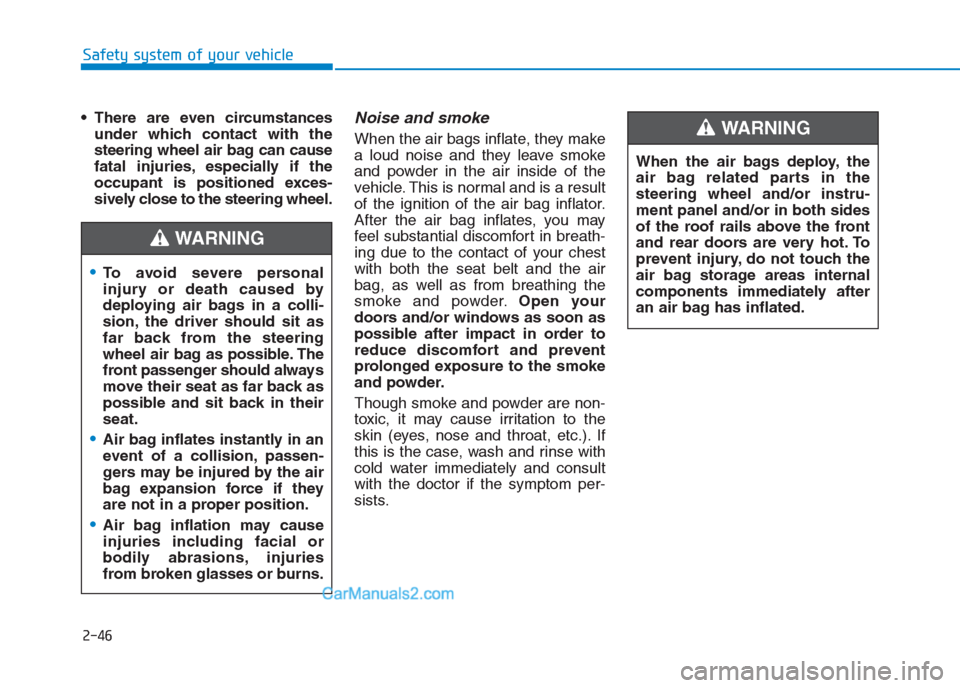
2-46
Safety system of your vehicle
There are even circumstances
under which contact with the
steering wheel air bag can cause
fatal injuries, especially if the
occupant is positioned exces-
sively close to the steering wheel.
Noise and smoke
When the air bags inflate, they make
a loud noise and they leave smoke
and powder in the air inside of the
vehicle. This is normal and is a result
of the ignition of the air bag inflator.
After the air bag inflates, you may
feel substantial discomfort in breath-
ing due to the contact of your chest
with both the seat belt and the air
bag, as well as from breathing the
smoke and powder.Open your
doors and/or windows as soon as
possible after impact in order to
reduce discomfort and prevent
prolonged exposure to the smoke
and powder.
Though smoke and powder are non-
toxic, it may cause irritation to the
skin (eyes, nose and throat, etc.). If
this is the case, wash and rinse with
cold water immediately and consult
with the doctor if the symptom per-
sists.
To avoid severe personal
injury or death caused by
deploying air bags in a colli-
sion, the driver should sit as
far back from the steering
wheel air bag as possible. The
front passenger should always
move their seat as far back as
possible and sit back in their
seat.
Air bag inflates instantly in an
event of a collision, passen-
gers may be injured by the air
bag expansion force if they
are not in a proper position.
Air bag inflation may cause
injuries including facial or
bodily abrasions, injuries
from broken glasses or burns.
When the air bags deploy, the
air bag related parts in the
steering wheel and/or instru-
ment panel and/or in both sides
of the roof rails above the front
and rear doors are very hot. To
prevent injury, do not touch the
air bag storage areas internal
components immediately after
an air bag has inflated.
WARNING
WARNING
Page 68 of 472
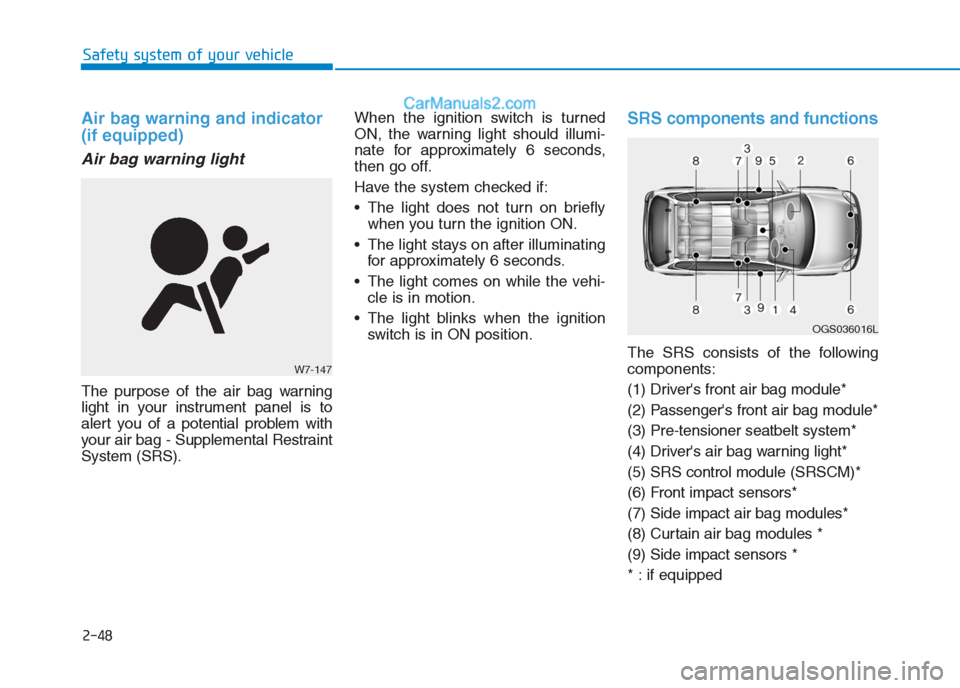
2-48
Safety system of your vehicle
Air bag warning and indicator
(if equipped)
Air bag warning light
The purpose of the air bag warning
light in your instrument panel is to
alert you of a potential problem with
your air bag - Supplemental Restraint
System (SRS).When the ignition switch is turned
ON, the warning light should illumi-
nate for approximately 6 seconds,
then go off.
Have the system checked if:
The light does not turn on briefly
when you turn the ignition ON.
The light stays on after illuminating
for approximately 6 seconds.
The light comes on while the vehi-
cle is in motion.
The light blinks when the ignition
switch is in ON position.
SRS components and functions
The SRS consists of the following
components:
(1) Driver's front air bag module*
(2) Passenger's front air bag module*
(3) Pre-tensioner seatbelt system*
(4) Driver's air bag warning light*
(5) SRS control module (SRSCM)*
(6) Front impact sensors*
(7) Side impact air bag modules*
(8) Curtain air bag modules *
(9) Side impact sensors *
* : if equipped
W7-147
OGS036016L
Page 69 of 472
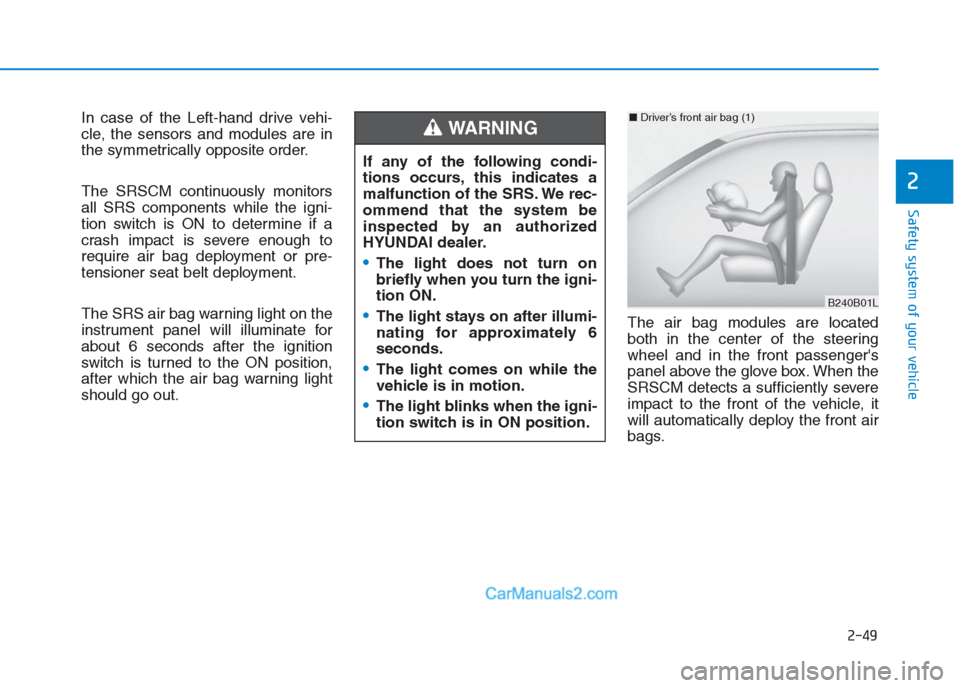
2-49
Safety system of your vehicle
2
In case of the Left-hand drive vehi-
cle, the sensors and modules are in
the symmetrically opposite order.
The SRSCM continuously monitors
all SRS components while the igni-
tion switch is ON to determine if a
crash impact is severe enough to
require air bag deployment or pre-
tensioner seat belt deployment.
The SRS air bag warning light on the
instrument panel will illuminate for
about 6 seconds after the ignition
switch is turned to the ON position,
after which the air bag warning light
should go out.The air bag modules are located
both in the center of the steering
wheel and in the front passenger's
panel above the glove box. When the
SRSCM detects a sufficiently severe
impact to the front of the vehicle, it
will automatically deploy the front air
bags. If any of the following condi-
tions occurs, this indicates a
malfunction of the SRS. We rec-
ommend that the system be
inspected by an authorized
HYUNDAI dealer.
The light does not turn on
briefly when you turn the igni-
tion ON.
The light stays on after illumi-
nating for approximately 6
seconds.
The light comes on while the
vehicle is in motion.
The light blinks when the igni-
tion switch is in ON position.
WARNING
B240B01L
■Driver’s front air bag (1)
Page 71 of 472
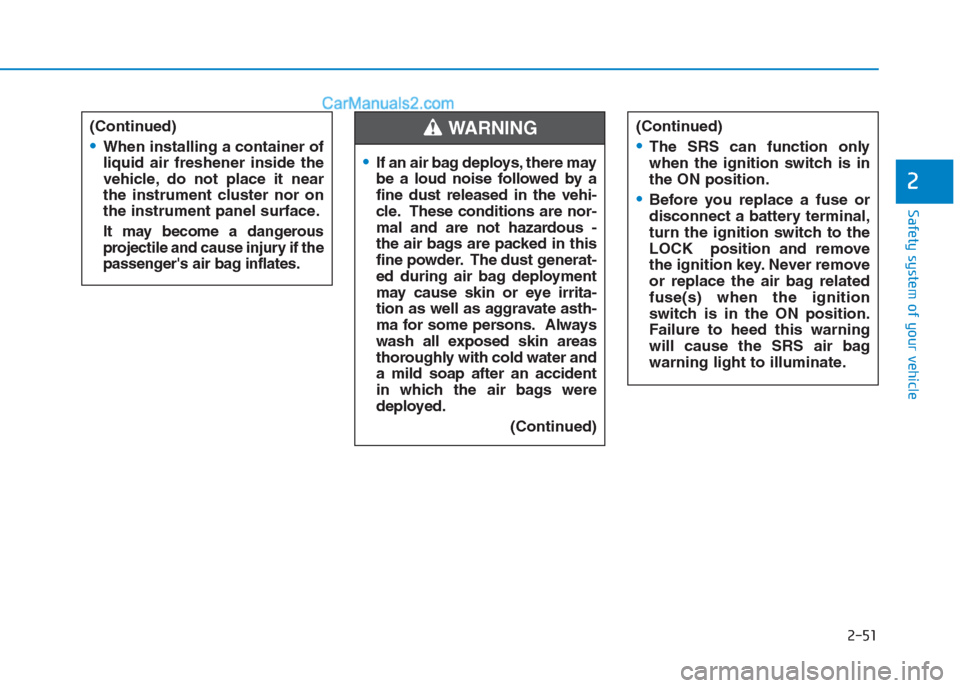
2-51
Safety system of your vehicle
2
(Continued)
When installing a container of
liquid air freshener inside the
vehicle, do not place it near
the instrument cluster nor on
the instrument panel surface.
It may become a dangerous
projectile and cause injury if the
passenger's air bag inflates.
If an air bag deploys, there may
be a loud noise followed by a
fine dust released in the vehi-
cle. These conditions are nor-
mal and are not hazardous -
the air bags are packed in this
fine powder. The dust generat-
ed during air bag deployment
may cause skin or eye irrita-
tion as well as aggravate asth-
ma for some persons. Always
wash all exposed skin areas
thoroughly with cold water and
a mild soap after an accident
in which the air bags were
deployed.
(Continued)
WARNING (Continued)
The SRS can function only
when the ignition switch is in
the ON position.
Before you replace a fuse or
disconnect a battery terminal,
turn the ignition switch to the
LOCK position and remove
the ignition key. Never remove
or replace the air bag related
fuse(s) when the ignition
switch is in the ON position.
Failure to heed this warning
will cause the SRS air bag
warning light to illuminate.
Page 74 of 472
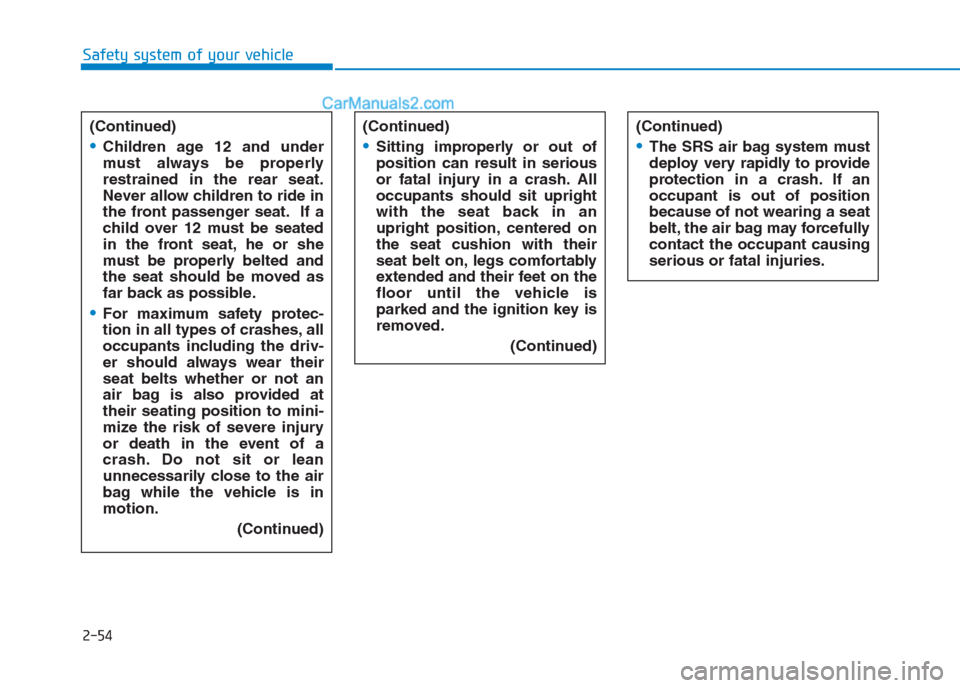
2-54
Safety system of your vehicle
(Continued)
Children age 12 and under
must always be properly
restrained in the rear seat.
Never allow children to ride in
the front passenger seat. If a
child over 12 must be seated
in the front seat, he or she
must be properly belted and
the seat should be moved as
far back as possible.
For maximum safety protec-
tion in all types of crashes, all
occupants including the driv-
er should always wear their
seat belts whether or not an
air bag is also provided at
their seating position to mini-
mize the risk of severe injury
or death in the event of a
crash. Do not sit or lean
unnecessarily close to the air
bag while the vehicle is in
motion.
(Continued)
(Continued)
Sitting improperly or out of
position can result in serious
or fatal injury in a crash. All
occupants should sit upright
with the seat back in an
upright position, centered on
the seat cushion with their
seat belt on, legs comfortably
extended and their feet on the
floor until the vehicle is
parked and the ignition key is
removed.
(Continued)
(Continued)
The SRS air bag system must
deploy very rapidly to provide
protection in a crash. If an
occupant is out of position
because of not wearing a seat
belt, the air bag may forcefully
contact the occupant causing
serious or fatal injuries.